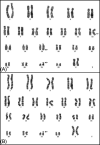Prenatal diagnosis of a de novo tetrasomy 15q24.3-25.3: Case report and literature review
- PMID: 32185823
- PMCID: PMC7370735
- DOI: 10.1002/jcla.23288
Prenatal diagnosis of a de novo tetrasomy 15q24.3-25.3: Case report and literature review
Abstract
Background: Terminal duplication on chromosome 15q is a rare chromosomal variation. Affected individuals show similar features such as growth dysplasia or the development of frontal bossing, body deformities, facial abnormalities, and genitourinary or cardiovascular disorders. However, it is not yet clear whether such 15q repeats lead to identifiable patterns of clinical abnormalities. Therefore, the purpose of this study was to analyze the prenatal diagnostic results and clinical manifestations of a fetus with 15q duplication and to summarize the literature.
Methods: The case was a fetus at 28 weeks of gestation. The risk of Down syndrome from second-trimester screening was 1/140. Prenatal ultrasound and amniocentesis were performed, and chromosomal microarray analysis (CMA) was used for genetic analysis.
Results: The fetus had abnormal clinical features, including intracardiac echogenic focus in the left ventricle, an aberrant right subclavian artery, and growth delay. The fetal chromosomal karyotype was 46,XX,15q?,12q?,21pstk+, and CMA revealed a 10.163 Mb duplication at 15q24.3-q25.3. The couple chose to terminate the pregnancy after careful consideration.
Conclusions: The combination and rational application of cytogenetics technology and molecular genetics technology such as CMA will open up the field of clinical application and provide useful genetic counseling for parents of fetuses carrying such chromosomal duplications.
Keywords: 15q duplication; abnormal ultrasound; chromosomal microarray analysis; genetic counseling; prenatal diagnosis.
© 2020 The Authors. Journal of Clinical Laboratory Analysis Published by Wiley Periodicals, Inc.
Conflict of interest statement
The authors declare that there is no conflict of interest.
Figures




Similar articles
-
Clinical, cytogenetic, and molecular analyses of prenatally diagnosed mosaic tetrasomy for distal chromosome 15q and review of the literature.Prenat Diagn. 2004 Oct;24(10):767-73. doi: 10.1002/pd.977. Prenat Diagn. 2004. PMID: 15503270 Review.
-
Chromosomal microarray analysis in fetuses with aberrant right subclavian artery.Ultrasound Obstet Gynecol. 2017 Mar;49(3):337-341. doi: 10.1002/uog.15935. Ultrasound Obstet Gynecol. 2017. PMID: 27063194
-
[ABERRANT RIGHT SUBCLAVIAN ARTERY (ARSA)--A NEW ULTRASOUND MARKER FOR CHROMOSOMAL FETAL ABNORMALITIES].Akush Ginekol (Sofiia). 2015;54(4):12-7. Akush Ginekol (Sofiia). 2015. PMID: 26410943 Bulgarian.
-
Prenatal diagnosis and molecular cytogenetic characterization of a chromosome 15q24 microdeletion.Taiwan J Obstet Gynecol. 2020 May;59(3):432-436. doi: 10.1016/j.tjog.2020.03.017. Taiwan J Obstet Gynecol. 2020. PMID: 32416893
-
Molecular cytogenetic characterization of 2q deletion and Xq duplication associated with nasal bone dysplasia in prenatal diagnosis: A case report and literature review.Taiwan J Obstet Gynecol. 2022 Jan;61(1):163-169. doi: 10.1016/j.tjog.2021.11.029. Taiwan J Obstet Gynecol. 2022. PMID: 35181032 Review.
Cited by
-
Novel autopsy and genetic findings in an acardiac twin: case report and literature review.Autops Case Rep. 2024 Mar 5;14:e2024477. doi: 10.4322/acr.2024.477. eCollection 2024. Autops Case Rep. 2024. PMID: 38487033 Free PMC article.
-
The Application of Optical Genome Mapping (OGM) in Severe Short Stature Caused by Duplication of 15q14q21.3.Genes (Basel). 2023 Apr 29;14(5):1016. doi: 10.3390/genes14051016. Genes (Basel). 2023. PMID: 37239376 Free PMC article.
References
-
- Zody MC, Garber M, Sharpe T, et al. Analysis of the DNA sequence and duplication history of human chromosome 15. Nature. 2006;440(7084):671‐675. - PubMed
-
- Zollino M, Tiziano F, Di Stefano C, Neri G. Partial duplication of the long arm of chromosome 15: confirmation of a causative role in craniosynostosis and definition of a 15q25‐qter trisomy syndrome. Am J Med Genet. 1999;87(5):391‐394. - PubMed
Publication types
MeSH terms
Supplementary concepts
Grants and funding
LinkOut - more resources
Full Text Sources
Medical
Miscellaneous

